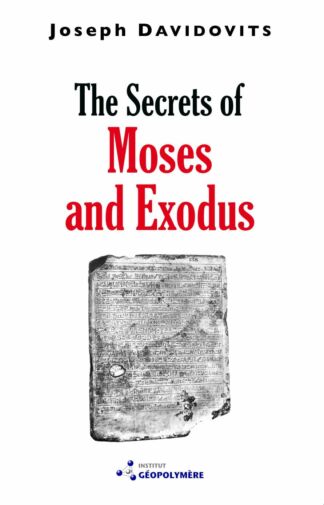Description
EGYPT and the BIBLE series
- The Secrets of Joseph the Patriarch
- The Secrets of the Merneptah-Israel Stele
- The Secrets of Moses and Exodus
- The Secrets of the Temple of Solomon
While searching for vestiges of the agglomeration technique (geopolymer stone) within ancient texts, Professor Davidovits was surprised to discover a remarkably clear association within the Bible. The reference appears just after the famous Ten Commandments, in Exodus, Chapter 20; Verse 25 (22): And if thou wilt make me an altar of stone, thou shalt not build it of hewn stone: for if thou lift up thy tool upon it, thou hast polluted it.
This eleventh Commandment in Moses’ law is quite significant. It governs the making of the altars erected during Exodus but also later. Jerusalem Temple was the ultimate altar. The fact that the stone used to build the altar could not be hewn, according to Moses’ law, suggests a different technique applied for its construction. In Verse 25 (22), the actual meaning would be thou shalt build the altar with agglomerated stone (a type of geopolymer stone of geopolymer concrete). The large size of Moses’ altar, involving 25 tons of stony material, required the consistent use of a transportable mold. It is the mold made of Shittim wood, described in Exodus 27, verses 1-8. Yet, how did they manage to find the ingredients, the ores and minerals implied in any artificial stone making process (geopolymer stone)? Professor Davidovits is presenting some interesting clues to demonstrate that, actually, Aaron’s breastplate with its 4 rows of 3 gems was a mineral “data bank” displaying four different systems useful for the making of altar stones.
As for Solomon’s Temple, verse 7 in 1 Kings 6 states: “it was built of stone made ready before it was brought thither: so that there was neither hammer nor axe nor any tool of iron heard in the house, while it was in building”. This is a valid clue for the agglomeration stone processing. The Hebrew text in the Torah further mentions that Solomon’s Temple was built with a special type of agglomerated stone written with the compound word spelled abonim yquros. This is a very ancient word, which was not understood by the writers of the Books of Kings and Chronicles and modern translators. Davidovits’ translation of all technical key words leads to a completely new and precise understanding on how the Temple of Solomon was built.
The book holds:
- 76 pages
- 5 chapters
- 6 figures and pictures
ISBN: 9782954453101







